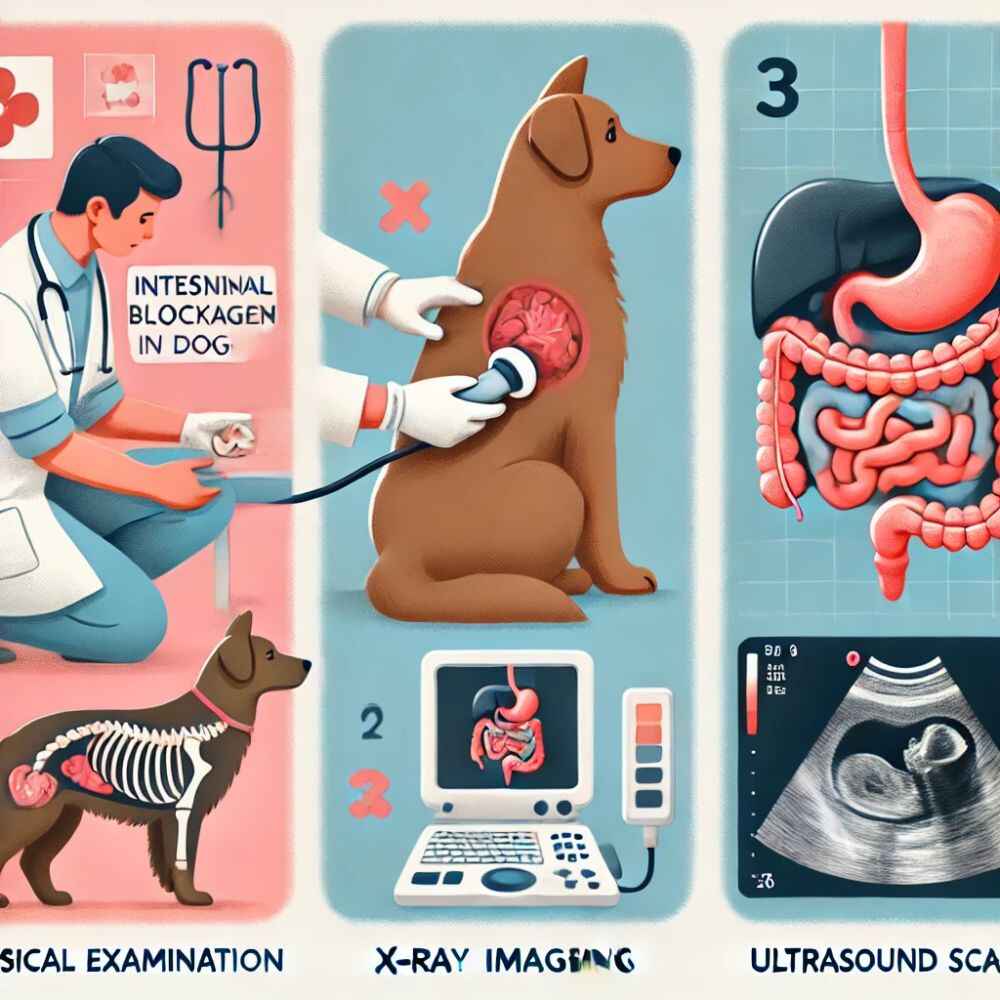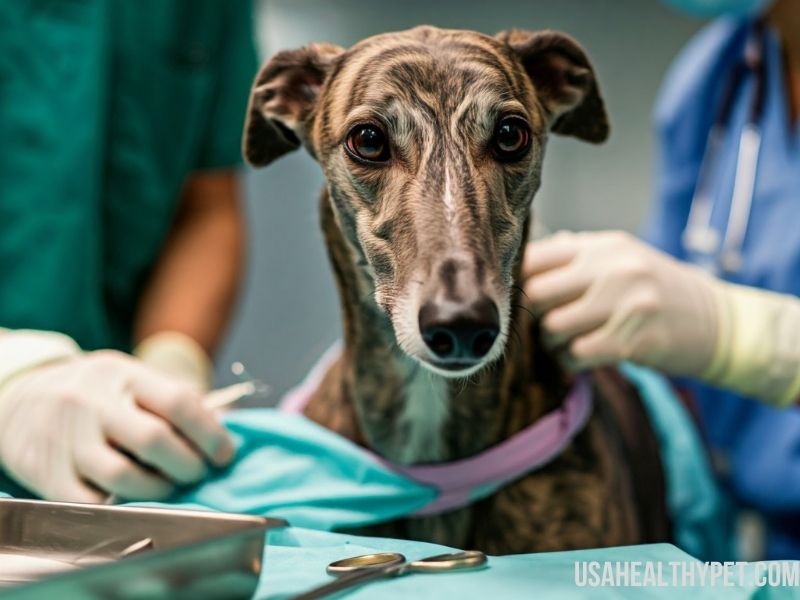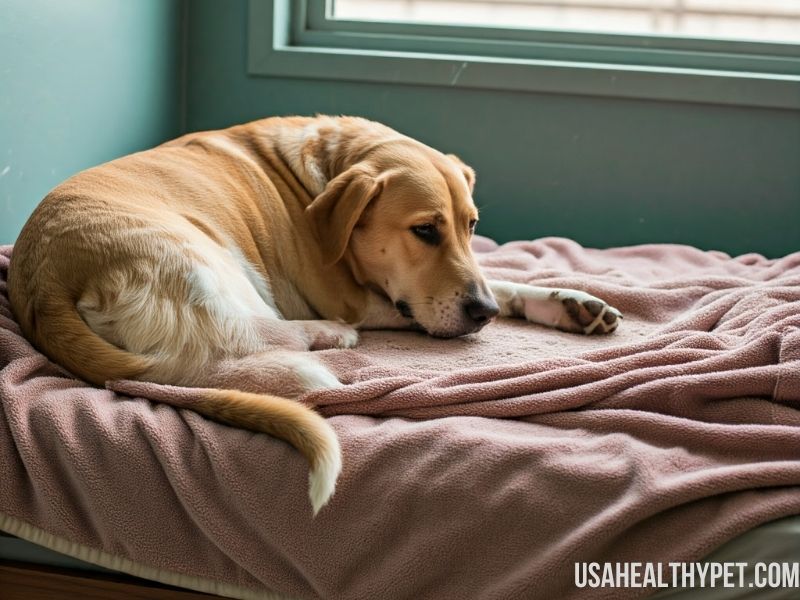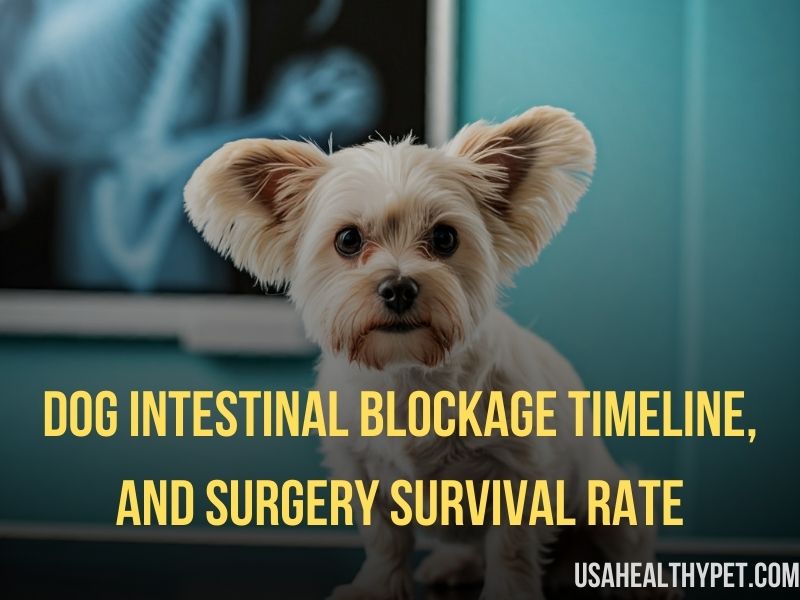Understanding Dog Intestinal Blockage
Intestinal blockage, also known as bowel obstruction, happens when your dog swallows something it shouldn’t, and it gets lodged in the digestive tract. If left untreated, it can become life-threatening.
Dogs are naturally curious and tend to investigate objects with their mouths, leading them to swallow items like toys, rocks, bones, or even pieces of clothing.
While some small objects might pass on their own, larger or jagged objects can get stuck and cause a blockage.
Key Points In Dog Intestinal Blockage Surgery Survival Rate
- Dog intestinal blockages are a serious condition that can be life-threatening if not treated promptly.
- Symptoms often include vomiting, bloating, abdominal pain, and lethargy, which typically appear within 6-24 hours of ingestion.
- Treatment options vary depending on the blockage’s severity and location, ranging from induced vomiting to surgery.
- Early intervention greatly increases survival rates, with surgery success rates generally ranging from 80% to 95% if caught in time.
- Preventive care like avoiding risky chew toys and household items can help reduce your dog’s risk of an intestinal blockage.
Common Causes of Intestinal Blockage in Dogs
Various items can lead to an intestinal blockage in dogs, and knowing what to look out for might help you prevent it. Here’s a list of common culprits:
- Toys and Balls: Small or broken toys are easy for dogs to swallow accidentally.
- Bones: Bones, especially cooked ones, can splinter and block the intestines.
- Sticks and Stones: These might sound harmless, but they’re notorious for getting stuck.
- Clothing and Fabric: Socks, underwear, and towels are surprisingly common items that dogs swallow.
- Strings and Ribbons: These can twist around the intestines, creating an even bigger problem.
Dogs might also consume random household items, and their chewing habits often give pet owners a scare. Keep an eye on what your dog plays with to minimize risk!

Symptoms of Intestinal Blockage in Dogs
Spotting symptoms early can make a significant difference in your dog’s health. Here are the tell-tale signs to watch for if you suspect an intestinal blockage:
- Vomiting: Often the first symptom to appear, and it may worsen as the blockage remains.
- Loss of Appetite: Dogs might refuse food or treats they usually enjoy.
- Abdominal Pain: They may whine, pant, or assume unusual postures to relieve discomfort.
- Lethargy: Lack of energy and enthusiasm, as the body focuses on the blockage.
- Bloating: Swelling in the abdomen is common with blockages.
- Diarrhea or Constipation: Changes in bathroom habits could be a sign.
If you notice a combination of these symptoms, it’s essential to get in touch with a veterinarian quickly. The sooner they examine your dog, the better the chances of recovery.
Dr. Sarah Wooten, DVM, emphasizes that “early recognition of symptoms like vomiting, loss of appetite, and abdominal swelling are key for timely intervention. The sooner you seek veterinary help, the better the chances of recovery without complications.” Studies show that survival rates are significantly higher in dogs that receive care within 24 hours of symptom onset.
Timeline of a Dog Intestinal Blockage: From Ingestion to Treatment
Understanding the timeline for an intestinal blockage can be crucial in managing the situation. Here’s what to expect in the hours and days following the ingestion of a foreign object:
- First Few Hours (Ingestion): Your dog might not show any symptoms right after swallowing an item. You may notice coughing or slight choking if the item was large.
- 6-24 Hours (Early Signs): Vomiting often starts in this window as the object tries to move through the intestines. Loss of appetite and abdominal pain may begin to show as well.
- 24-48 Hours (Severe Symptoms): Without treatment, vomiting continues, and signs of lethargy and abdominal swelling become prominent. Dehydration can also occur due to constant vomiting.
- 48+ Hours (Critical Stage): By this point, the blockage can cause severe internal damage. This stage can result in severe complications, even tissue death in the intestines.
The quicker you can respond, the more likely your dog can avoid surgery and recover without complications. A delay in treatment is risky, so keep a close eye on any unusual behavior.

Diagnosis of Intestinal Blockage in Dogs
If you suspect an intestinal blockage, the vet’s first step will be a thorough examination. Here’s what the diagnostic process typically involves:
- Physical Examination: The vet will feel the dog’s abdomen to check for unusual swelling or tenderness.
- X-Rays or Ultrasound: These imaging techniques can identify blockages and their location within the digestive system.
- Blood Tests: A blood test may reveal signs of dehydration or infection.
- Endoscopy (Sometimes): In certain cases, an endoscope is used to view or retrieve an object in the stomach or upper intestines.
Early diagnosis increases the odds of a simpler, less invasive treatment. A delayed diagnosis may result in the need for immediate surgery to remove the blockage.
Treatment Options for Intestinal Blockage
The right treatment depends on the blockage’s location, severity, and the size and type of object. Here’s an overview of potential treatments:
- Inducing Vomiting (If Safe): If the blockage is caught early and is small, vets may try inducing vomiting. This is typically only recommended if the object is non-toxic and the blockage is in the stomach.
- Endoscopic Removal: For objects that haven’t moved far into the intestines, an endoscope can sometimes be used to remove them without surgery.
- Surgery (Enterotomy): In more severe cases, surgery may be required to remove the blockage. This is an invasive option, but it’s often the best chance for saving the dog’s life if the object is too large or has moved into the intestines.
Surgery is common in severe cases, but the success rate is generally high with prompt action and post-operative care.
What to Expect from Surgery for Intestinal Blockage
If your dog requires surgery, here’s a general rundown of what happens:
- Pre-Surgery Prep: Your vet may stabilize your dog with IV fluids, pain relief, and antibiotics to reduce the risk of infection.
- Surgical Procedure: The surgeon will make an incision to remove the object and, if necessary, any damaged tissue around it.
- Post-Surgery Monitoring: After surgery, your dog will need to be monitored for signs of infection or complications.
Surgery can sound scary, but most dogs recover well with attentive care. The vet will guide you on what to expect, including possible risks and the timeline for a full recovery.

Recovery Process after Surgery
The post-surgery recovery period can last a few weeks, depending on the severity of the blockage and your dog’s health. Here’s what you might expect:
- Restricted Activity: Dogs will need rest to allow their digestive system to heal, and exercise should be limited.
- Dietary Changes: A soft or special diet will be required initially to avoid stressing the intestines.
- Medication and Pain Management: The vet may prescribe pain relief and antibiotics to prevent infections.
- Follow-Up Visits: Regular check-ins with the vet are crucial for monitoring the healing process and ensuring there are no complications.
You’ll be your dog’s caretaker during recovery, so following the vet’s advice is essential to getting them back to full health!
Survival Rate for Dogs with Intestinal Blockage Surgery
Survival rates for dogs undergoing surgery to remove an intestinal blockage are encouraging. When treated promptly, most dogs have a high chance of recovery, with a success rate between 80% and 95%.
However, the survival rate can vary based on factors like:
- Time of intervention: The sooner the blockage is addressed, the better the chances.
- Dog’s overall health: Younger, healthier dogs tend to recover faster.
- Severity of blockage: Blockages with minimal intestinal damage have higher recovery rates.
Prompt action is the best way to ensure a positive outcome. So, if your dog starts showing symptoms, don’t hesitate to get to a vet.
According to research published in The Journal of Veterinary Medicine, the survival rate for dogs undergoing surgery for intestinal blockages is over 80% if treated promptly. Veterinary surgeon Dr. Jonathan Hall adds, “Timely surgery greatly minimizes risks. However, success also depends on factors like the size of the object, its location, and any prior intestinal damage.”
Preventing Intestinal Blockages in Dogs
Prevention is always the best cure! Here are some tips to reduce the risk:
- Keep small objects out of reach: Ensure toys and household items are dog-proof.
- Provide safe chew toys: Bones and certain chew toys can pose a risk.
- Avoid giving human food scraps: Certain foods can be tempting but may contain small bones.
- Training: Teach your dog basic commands like “leave it” to prevent them from grabbing random objects.

Cost of Treatment and Surgery for Intestinal Blockage
Treatment costs can vary widely, especially if surgery is involved. Here’s a rough estimate:
- Diagnosis and Initial Exam: $100 to $500
- Endoscopic Removal: $800 to $2,000
- Surgery: $1,500 to $5,000 depending on complexity and location
How to Support Your Dog during Recovery
After treatment, your dog will need your care and attention. Here’s how to support them:
- Give Medication on Schedule: Ensure you follow the vet’s prescription instructions closely.
- Adjust Diet Carefully: Stick to the vet-recommended food and monitor for any signs of discomfort.
- Keep Them Comfortable: Create a calm, cozy space for your dog to rest.
Conclusion and Key Takeaways
Intestinal blockages are serious, but with prompt care, they’re treatable. Knowing the symptoms, acting fast, and getting the right care can save your dog’s life.
Remember, your dog relies on you to keep them safe, so take preventive steps, watch for signs, and always trust your instincts if something seems off.
If you suspect an issue, reach out to a vet right away—acting quickly is the best thing you can do for your furry friend’s health.
Disclaimer
This article is for informational purposes only and is not a substitute for professional veterinary advice. Always consult your veterinarian regarding any symptoms or health concerns in your pet.
FAQs
- How long does it take for symptoms to appear after ingestion?
- Symptoms can start within 6-24 hours but vary depending on the object and dog.
- Can my dog pass an obstruction naturally?
- Small objects might pass naturally, but most blockages require veterinary help.
- Is surgery always necessary for intestinal blockages?
- Not always, but many cases do require surgery to remove the object.
- What happens if I delay treatment for a blockage?
- Delaying can lead to severe complications, making surgery riskier and reducing survival chances.
- How can I tell if my dog is in pain from a blockage?
- Signs include whining, restlessness, and a swollen belly.

Pingback: Can Dogs Eat Cooked Beans? A Complete Guide